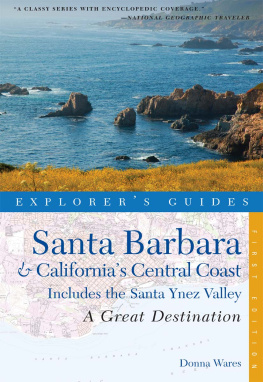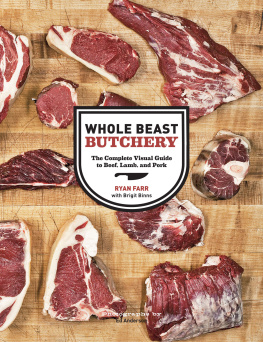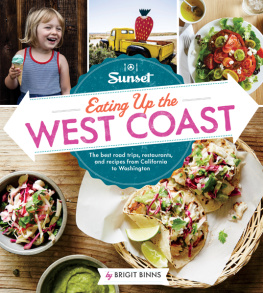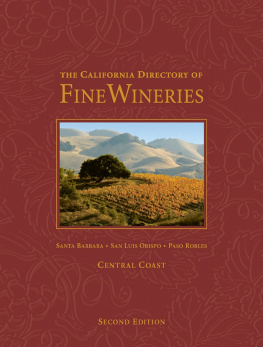Acknowledgments
This was a far more collaborative book than any Ive written before, and thus many thanks are due to the following:
To Mary Baker, for encouraging meand opening doorsin the earliest days of the concept; Stacy Jacob, Clark Staub, and Sonja Magdevski for helping with the difficult job of narrowing down the many choices for the profiles (special thanks to Sonja for her all-around selfless enthusiasm and assistance); Chris Taranto, for excellent, knowledgeable guidance on so many levels; and Jen Porter, for her world-class promotional savvy.
To Colin Clark, for his stunning photography, and especially his game willingness to go way out of his way to capture more and better images than I could have hoped for. And to Valerie Aikman-Smith, for her expertise in making my food look as wonderful as it tastes.
To the wine pairersAli Carscarden, Sonja Magdevski, Cris Cherry, Stephan Asseo, Wes Hagen, Chris and Shandi Kobayashi, Frank Ostini, and Anne Twigg.
To the 25 winemakers and food artisans who took the time to share their passions, their past, and their plans for the future in this book.
To Mark and Maggie at Windward, Jennifer and Terry at Hoage, Jackie at Lone Madrone, Georges and Daniel at Daou, Denis at Domaine Degher, Judy at Starr Ranch, Guillaume and Solne at Clos Solne, Pam at Caliza, Alex and Monica at Villicana, Larry at Via Vega, Neal at Morro Bay Oysters, Debbie at Thomas Hill, and the many other artisans who strive to produce excellent wine and food in the Central Coast region but, because of space constraints, didnt make it into this book.
To Clark Staub, for lending his superior expertise to the wood-oven chapter.
To Carole Bidnick, for being the Jewish mother I didnt get to have; Kirsty Melville, for her confidence in me over the past decade or so; Jean Lucas, for her vision and refreshingly collaborative editing process. Also at Andrews McMeel Publishingthe ebullient Emily Farris, Diane Marsh (for the stunning design), and Lynne McAdoo.
And finally, to my great friend Andrea DeWit, who tested and tasted recipes, styled food, washed dishes, encouraged me, and kept me focused when the going got tough. And to her husband, Michael, for always sensing the perfect moment to open a great bottle.
To my mother, Marcia Lgre Binns, for making sure I was born in California.
CHAPTER 1
Magic-Hour Grazing
In wine country, magic hour refers to that golden, relaxed time between the activity of the day and dinner. We like to stretch it out to more than just an hour, and that means every host needs a trusty repertoire of delicious, user- and wine-friendly snacks. Cheese is a natural partner for wine, and youll see a lot of it in this chapter. Christina Maguire (Rinconada Dairy, in Santa Margarita) makes some of the finest. Antonio Varia (chef-owner of Buona Tavola Italian restaurant, in Paso Robles) began making small-batch cured meats under the name Allesina in 2010. Using no nitrates or preservatives, he creates to-die-for salumi, sausages, and a decadent, soft salami spread called nduja. If you are simply too relaxed to contemplate cooking (even one of the many simple preparations in this chapter), then a selection of perfectly ripened honest cheeses and salumi will take you happily through the golden hour to dinnertime.
Wine pairings by Ali Carscarden of 15C
Sheeps Cheese Gougres
These crisp little puffs are like rich, cheese-flavored air. If you have some dry-aged ham on hand (serrano, prosciutto, Virginia country ham), split a gougre like a sandwich and put a little sliver of ham in the middle. Youll thank me. The make-ahead bonus here: Let the finished dough (called pte choux , in French) stand, covered, for up to an hour before forming and finishing the cheesy puffs. MAKES ABOUT 30 SMALL PUFFS
cup whole milk
cup water
4 tablespoons unsalted butter, cut into cubes
teaspoon fine sea salt
Freshly ground black pepper
cup all-purpose flour
2 eggs
teaspoon minced fresh rosemary
cup grated Central Coast sheeps cheese, or a young pecorino or Manchego (about 3 ounces)
Preheat the oven to 425F and line a baking sheet with parchment paper. (Or use nonstick baking sheets.)
In a saucepan, combine the milk, water, butter, salt, and a bit of pepper. Place over high heat and simmer until the butter is melted. Remove from the heat and dump in the flour all at once; immediately stir energetically (and constantly) until the mixture pulls away from the sides of the pan and starts to look smooth, 1 to 2 minutes. Return the pan to the heat for 1 minute, continuing to stir vigorously; remove again and let rest for about 3 minutes.
Add the eggs, one at a time, stirring quickly and thoroughly to fully incorporate each one before adding the next. The batter will first appear lumpy, but after a minute or so will become thick, shiny, and smooth. Add the rosemary and cheese; stir until fully blended. (At this point, you may cover the pan and let the dough stand for up to 1 hour before finishing the puffs.)
Using two teaspoons, make approximately 1-tablespoon mounds on the prepared baking sheet, leaving about 1 inch between the mounds.
Bake for 10 minutes, then turn the oven down to 375F and bake for 20 to 25 minutes more, until the puffs are doubled in size and a lovely golden brown all over, including the sides. Serve warm. (Or reheat the cooled cheese puffs in a low oven for 5 to 10 minutes before serving; dont overdo it or they will be very dry.)
CENTRAL COAST: Clavo Vermentino Voluptuous, Paso Robles
FARTHER AFIELD: Costamolino Vermentino, Sardinia, Italy
Melon Wedges with Orzo and Blue Cheese Salad
Neon orange melon lends visual spark to the creamy white pasta mixture, while earthy blue cheese is a fantastic partner for the cool, sweet fruit. If your event calls for plated appetizers, simply cut crosswise circles of melon, remove the seeds, and place a large scoop of the cheesy salad in the center. The salad may be made up to 8 hours ahead; the melon wedges may be cut, covered with plastic wrap, and refrigerated for up to 4 hours. MAKES ABOUT 40 BITES
6 ounces mild blue cheese, at room temperature
3 tablespoons fresh lemon juice
2 tablespoons Dijon mustard
cup heavy cream
2 large shallots, finely chopped (about cup)
1 celery rib, finely diced
cup finely chopped fresh flat-leaf parsley
Freshly ground black pepper
4 ounces orzo (or use small elbow macaroni)
1 small ripe cantaloupe
Bring a large pan of lightly salted water to a boil for the orzo. In a large bowl, combine the blue cheese, lemon juice, and mustard. Mash with a fork until the cheese is broken up but still quite lumpy. Whisk in the cream and then add the shallots, celery, and parsley. Mix well and add black pepper to taste. Taste for salt and add a little, if necessary.
Cook the orzo in the boiling water until al dente, according to the package directions. Drain in a colander and then rinse thoroughly with cold water to remove excess starch. Shake the colander well, and toss the drained pasta with the cheese mixture.
Slice the cantaloupe in half crosswise and scoop out all the seeds. Cut each half into -inch rounds and then trim away the outer peel, leaving a large, flat doughnut shape. Cut each circle into 6 equal wedges. (There will be some off cuts from the ends that are not usable; eat them!)
Place the cantaloupe wedges on a large platter and top each with about a tablespoon of the pasta salad.
CENTRAL COAST: Bodegas M Albario, Paso Robles
FARTHER AFIELD: Paco & Lola Albario, Rias Baixas, Spain
Rainbow Radishes with Anchovy Butter
Radishes are served with sweet butter throughout France, from Provence to Paris. Tart and cool radishes are perfectly paired with rich and creamy butter. At the farmers market, look for white, black, French Breakfast, and Misato Rose radishes. Every day it seems there are new (old) radishes to feast our eyes and taste buds upon.
Next page








